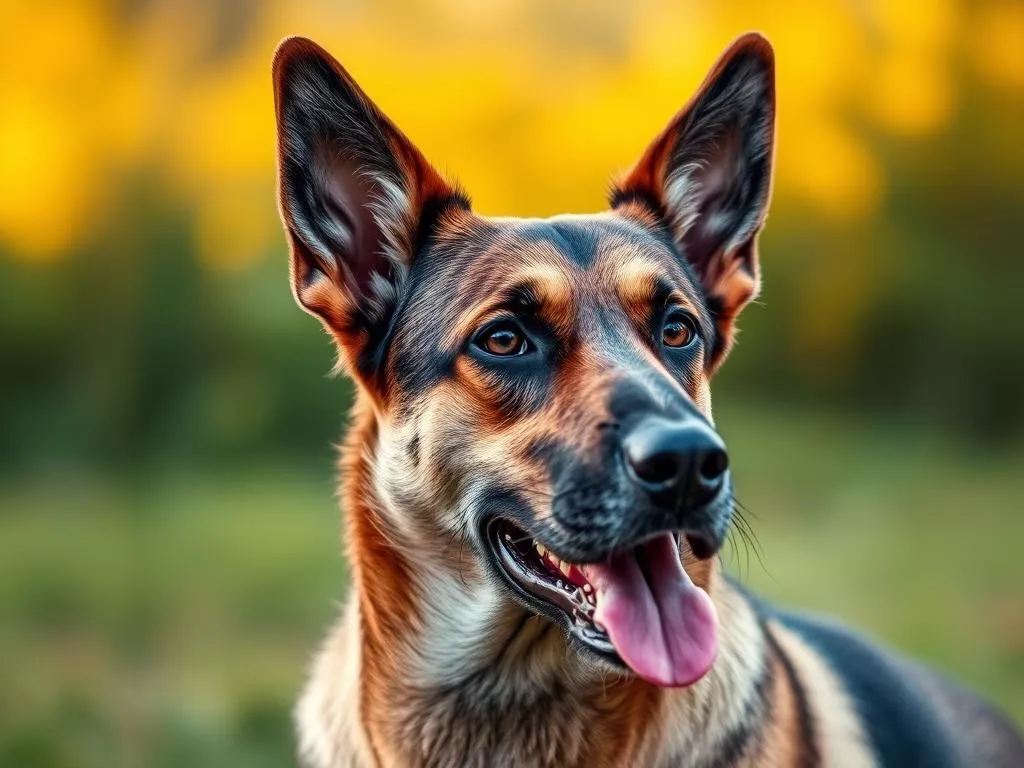
Introduction
The Whippet German Shepherd mix (WGS) is a unique hybrid dog that combines the best traits of its parent breeds. Understanding mixed breeds like the WGS is essential for potential owners, as they can inherit a variety of characteristics from both parents. The Whippet, known for its speed and agility, and the German Shepherd, renowned for its intelligence and loyalty, come together to create a dog that is both energetic and devoted. This guide will delve into the traits, care needs, and lifestyle requirements of the Whippet German Shepherd mix.
Understanding the Parent Breeds
Whippet
The Whippet has a rich history that dates back to the 19th century in England. Originally bred for hunting small game and as a racing dog, the Whippet is known for its remarkable speed—often reaching up to 35 miles per hour.
Physical Characteristics: Whippets are medium-sized dogs, typically weighing between 25 to 40 pounds and standing about 18 to 22 inches tall at the shoulder. Their coat is short, smooth, and comes in various colors, including fawn, black, blue, and brindle.
Temperament: Whippets are affectionate, gentle, and friendly. They are known for their calm demeanor and are often described as “couch potatoes” when not exercising. However, they thrive on companionship and love to be around their families.
Common Health Issues: While generally healthy, Whippets can be prone to certain conditions such as hip dysplasia, heart issues, and sensitivity to temperature changes due to their short coat.
German Shepherd
German Shepherds are one of the most popular dog breeds worldwide, known for their intelligence and versatility. They were originally bred in Germany for herding sheep and have since excelled in various roles, including as police and service dogs.
Physical Characteristics: German Shepherds are larger than Whippets, typically weighing between 50 to 90 pounds and standing 22 to 26 inches tall. They have a dense double coat that can be black and tan, sable, or solid black.
Temperament: German Shepherds are known for their loyalty, courage, and trainability. They are protective of their families and can be wary of strangers, making proper socialization crucial from a young age.
Common Health Issues: German Shepherds may face health issues such as hip and elbow dysplasia, degenerative myelopathy, and certain heart conditions.
The Whippet German Shepherd Mix
Appearance
The appearance of a Whippet German Shepherd mix can vary widely, depending on which traits they inherit from their parents. Generally, you can expect a medium to large-sized dog, weighing between 30 to 70 pounds.
Coat Characteristics: The coat may be short like a Whippet’s or have the double coat of a German Shepherd. Colors can vary significantly, including combinations of black, tan, fawn, or brindle. The texture can range from smooth to slightly coarse.
Distinctive Features: The WGS might inherit the sleek body of the Whippet combined with the broader head and ears of the German Shepherd, resulting in a unique and striking appearance.
Temperament
The WGS is likely to inherit a blend of traits from both parent breeds, resulting in a dog that is both energetic and affectionate.
Behavioral Traits: These dogs are usually friendly, intelligent, and eager to please. They can be playful and enjoy engaging in activities with their families.
Socialization Needs: Early socialization is crucial for a WGS, as they may inherit the German Shepherd’s protective instincts. Exposing them to various environments, people, and other animals will help them develop into well-rounded adults.
Energy Levels: This mix tends to have high energy levels, requiring regular exercise to keep them physically and mentally stimulated. Daily walks, playtime, and interactive games are essential.
Health Considerations
The Whippet German Shepherd mix can inherit health issues from both parent breeds.
Common Health Issues: Potential concerns include hip dysplasia, heart problems, and sensitivity to temperature extremes. Regular vet check-ups can help catch any issues early.
Lifespan Expectations: Generally, WGS dogs can live between 10 to 15 years, depending on their overall health and care.
Importance of Regular Vet Check-Ups: Keeping up with vaccinations, dental care, and routine check-ups is crucial to maintain the health of a WGS.
Training and Socialization
Training Needs
Training a Whippet German Shepherd mix requires consistency and patience.
Obedience Training Recommendations: Start with basic commands and gradually incorporate more advanced training as your dog masters the basics. Early training helps build a strong bond and establishes good behavior.
Best Practices for Training a WGS: Use positive reinforcement techniques such as treats, praise, and playtime. This encourages your dog to learn and respond positively to commands.
Positive Reinforcement Techniques: Rewarding desired behaviors rather than punishing unwanted ones creates a positive learning environment.
Socialization
Socializing your WGS from a young age is essential for their development.
Importance of Early Socialization: Introducing your dog to various situations helps reduce anxiety and aggression later in life.
Recommended Socialization Activities: Puppy classes, playdates with other dogs, and trips to busy parks can provide excellent socialization opportunities.
Dealing with Potential Behavioral Issues: If your WGS shows signs of anxiety or aggression, consult a professional trainer or behaviorist for guidance.
Care and Maintenance
Grooming
Grooming needs may vary between individual dogs based on their coat type.
Grooming Needs and Frequency: A WGS with a short coat may require minimal grooming, while a dog with a double coat will need regular brushing to prevent matting and reduce shedding.
Best Products for Coat Care: Invest in quality brushes and grooming tools suited for your dog’s coat type to maintain a healthy appearance.
Nutrition
Proper nutrition is crucial for a healthy WGS.
Dietary Requirements: A balanced diet rich in protein, healthy fats, and essential nutrients is vital. Consider high-quality dog food formulated for active breeds.
Recommended Types of Dog Food: Look for brands that list meat as the first ingredient and avoid fillers like corn and soy.
Exercise
Regular exercise is essential for maintaining a happy and healthy WGS.
Daily Exercise Needs: Aim for at least 60 minutes of exercise each day, incorporating walks, runs, and playtime.
Fun Activities to Keep a WGS Engaged: Engaging activities like agility training, fetch, and swimming can provide both physical and mental stimulation.
Living with a Whippet German Shepherd Mix
Ideal Living Conditions
Understanding the living needs of a Whippet German Shepherd mix is crucial for potential owners.
Suitable Living Environments: WGS dogs can adapt to various living situations, including apartments or houses, as long as they receive enough exercise.
Space Requirements for Exercise: A house with a yard is ideal, but daily trips to parks or open spaces can suffice for apartment dwellers.
Compatibility with Families and Other Pets
The WGS can be a wonderful addition to families and can coexist with other pets.
How WGS Interact with Children: Generally, they are good with children, loving to play and engage. However, supervision during playtime is advisable.
Interaction with Other Pets: Early socialization can help them get along with other dogs and animals, though some may have a higher prey drive due to their Whippet heritage.
Tips for Introducing a WGS to Existing Pets: Gradual introductions and positive reinforcement can help ease the transition for all animals involved.
Pros and Cons of Owning a Whippet German Shepherd Mix
Advantages
Owning a Whippet German Shepherd mix comes with many unique qualities.
Unique Qualities of the WGS: This mix often combines the speed and agility of the Whippet with the intelligence and loyalty of the German Shepherd, creating a versatile and trainable companion.
Benefits of Mixed Breed Ownership: Mixed breeds often benefit from hybrid vigor, which can lead to better overall health compared to purebreds.
Disadvantages
However, potential owners should also consider the challenges of ownership.
Potential Challenges of Ownership: High energy levels and the need for regular exercise may not suit every lifestyle, particularly for those who prefer a more relaxed pet.
Considerations for Prospective Owners: Ensure you can provide the time, attention, and resources necessary for a WGS to thrive.
Conclusion
The Whippet German Shepherd mix is a fascinating hybrid that can make a loving and loyal companion. Understanding the traits, care needs, and lifestyle requirements of this mix is crucial for potential owners. With proper training, socialization, and care, a WGS can be a wonderful addition to any family. Responsible pet ownership ensures that these dogs can live happy, fulfilling lives alongside their human companions.
FAQs
What is the ideal exercise routine for a Whippet German Shepherd mix?
A daily routine of at least 60 minutes of varied exercise, including walks, playtime, and mental stimulation, is ideal for a WGS.
Are Whippet German Shepherd mixes good with children?
Yes, they generally have a friendly disposition and can be good with children, but supervision during play is always recommended.
What are common health issues to watch for in a WGS?
Common health concerns include hip dysplasia, heart issues, and sensitivity to temperature extremes. Regular vet check-ups are essential.
How should I train my Whippet German Shepherd mix?
Use positive reinforcement techniques for training, starting with basic commands and gradually advancing to more complex tasks.
Can a WGS adapt to apartment living?
Yes, as long as they receive sufficient exercise and mental stimulation, a WGS can adapt well to apartment living.
By understanding the characteristics of the Whippet German Shepherd mix, prospective owners can make informed decisions and enjoy the rewarding experience of pet ownership.









